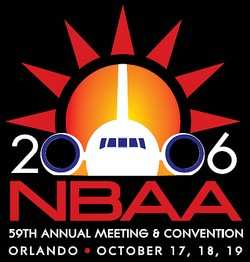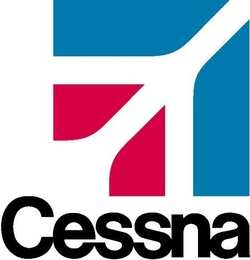Swept-Wing Citation Will Feature More Room, Single-Point
Refueling
 Cessna told ANN several
weeks ago that this year's National Business Aviation Association
conference in Orlando, FL would be a big one for the company... and
as promised, Cessna is already having a BIG show. In addition to
announcing a proof-of-concept program for a large-cabin
business jet, Cessna also formally launched the new
Citation CJ4 business jet at the show Monday, with more than 70
orders already on the books.
Cessna told ANN several
weeks ago that this year's National Business Aviation Association
conference in Orlando, FL would be a big one for the company... and
as promised, Cessna is already having a BIG show. In addition to
announcing a proof-of-concept program for a large-cabin
business jet, Cessna also formally launched the new
Citation CJ4 business jet at the show Monday, with more than 70
orders already on the books.
"We've used new technology developed from our latest jet models,
such as the Citation Mustang and the Citation Sovereign, as well as
advances targeted specifically at the CJ4, to create an airplane
that is truly a combination of top-notch engineering advances,"
said Cessna Chairman, President and Chief Executive Officer Jack J.
Pelton. "The CJ4 offers the strongest performance and payload
balance yet in the CJ series, with more standard features and
passenger comforts than ever before. Rather than just a stretched
CJ3, the Citation CJ4 is a true upward extension to the
single-pilot-certified family of Citations. It does share the CJ
pedigree and will certainly follow the success of the Citation
CJ1+, CJ2+ and CJ3 (shown below), while offering the amenities and
system architecture our customers in 2010 will demand."
As Aero-News reported, first
flight of the CJ4 is scheduled for the first half of 2008 and entry
into service is set for the first half of 2010. The introductory
price is expected to be $7.995 million in 2006 dollars. Since
launching the program several weeks ago, Cessna already has taken
more than 70 orders for the new jet, 25 of which will be included
in third quarter backlog for contracts that were completed by the
end of September.
The newly engineered wing of the CJ4 is moderately swept. Some
features of the wing are similar to the Sovereign, including the
three upper speed brake panels on each wing, which allow the
airplane to have the short field performance the CJ series is known
for. The CJ4 can takeoff from runways as short as 3,300 feet and
land on runways as short as 2,665 feet.

The new Williams International FJ44-4A electronically controlled
(FADEC) engine will debut on the CJ4. The twin engines each provide
3,400 pounds of thrust, compared to 2,820 pounds of the CJ3's
FJ44-3A. The aircraft will be certified for operations up to 45,000
feet. The electric rudder and aileron trim are new features, as is
single-point refueling for the aircraft.
Passengers boarding will find a wider cabin door like the
Mustang, new generation seat design with increased head and
shoulder room, a total of four inches more foot room in the cabin,
and more storage when compared to the CJ3. The window placements
are positioned for optimal passenger viewing.
 The CJ4 will have a
standard integrated cabin management system for lighting, electric
shades, and a home-theater-like digital entertainment suite. The
system will allow a selection of media, such as DVD, CD, MP3 and XM
satellite radio. Accommodations for other devices, such as iPods,
are also included. And, not only will the pilots have split fan
speed on the climate control in the cockpit, but passengers will be
able to select their own temperature setting for the cabin.
The CJ4 will have a
standard integrated cabin management system for lighting, electric
shades, and a home-theater-like digital entertainment suite. The
system will allow a selection of media, such as DVD, CD, MP3 and XM
satellite radio. Accommodations for other devices, such as iPods,
are also included. And, not only will the pilots have split fan
speed on the climate control in the cockpit, but passengers will be
able to select their own temperature setting for the cabin.
Electrically heated glass windshields and side windows will
provide a quieter environment in the cockpit. Pilots will find
easier entry into the cockpit with an improved, ergonomic pedestal
arrangement, as well as more than two inches more legroom than the
CJ3. The Collins Pro Line 21 avionics suite is a clean design and
features four 8-by-10 inch flat screen displays. For a quick
reference of how the airplane's main systems are performing, the
engine indication and crew alerting system (EICAS) displays
summarized systems operating parameters on the multifunctional
displays (MFDs).
Two control display units (CDUs) are positioned on the tilt
panel to provide the interface for radio tuning and the single
flight management system (FMS). TAWS Class A (terrain awareness
warning system), TCAS II (traffic alert and collision avoidance
system), cockpit voice recorder (CVR), electronic charts, and XM
graphical weather are just part of the standard capabilities.
An essential electrical bus architecture breaks new ground for
this class of aircraft with multiple power sources to provide much
higher reliability and greater situation awareness in the event of
an electrical emergency. This functionality includes continued
power to all four displays and the autopilot.
The Citation CJ4 will join the CJ1+, CJ2+ and CJ3, which have
amassed more than 900 airplanes in the fleet with more than 1.3
million flight hours.
 NTSB Final Report: Cozy Cub
NTSB Final Report: Cozy Cub ANN FAQ: Contributing To Aero-TV
ANN FAQ: Contributing To Aero-TV Classic Aero-TV: Seated On The Edge Of Forever -- A PPC's Bird's Eye View
Classic Aero-TV: Seated On The Edge Of Forever -- A PPC's Bird's Eye View ANN's Daily Aero-Linx (04.29.25)
ANN's Daily Aero-Linx (04.29.25) ANN's Daily Aero-Term (04.29.25): Execute Missed Approach
ANN's Daily Aero-Term (04.29.25): Execute Missed Approach





